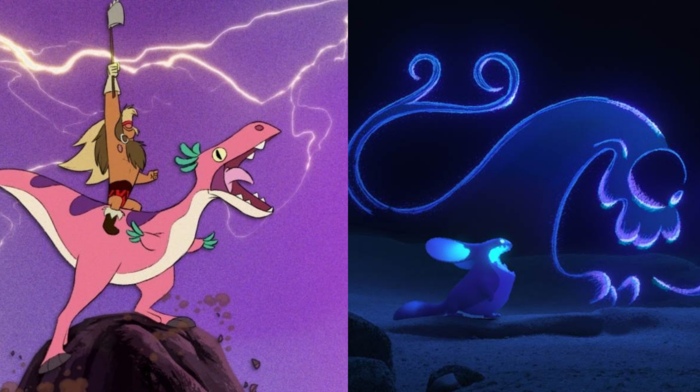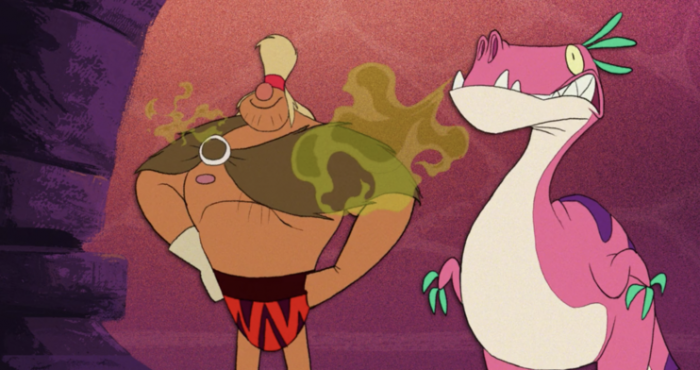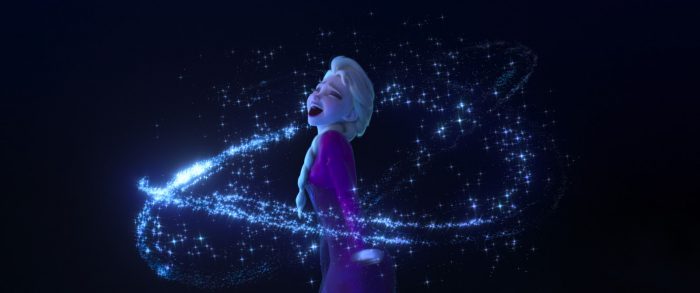
Season 2 of Disney’s experimental short series Short Circuit just launched on Disney+ and if you’re lacking your daily dose of fun, you might want to check it out. This season features five shorts from animators across the studio, that vary wildly in their tones and styles.
I spoke with two of the filmmakers behind the wonderfully creative shorts, Dinosaur Barbarian and Songs to Sing in the Dark. These two are the perfect example of how broad the Short Circuit selection can be. Dinosaur Barbarian is a musical intro to a non-existent show about a barbarian learning to take care of himself, while Songs to Sing in the Dark is a journey into a dark cave, where two creatures are battling for dominance.
In our chat, directors Kim Hazel and Riannon Delanoy shared their inspirations for the shorts, and all that they learned from working on Disney features like Moana and Frozen II.
Something about these two shorts made me feel so nostalgic. I’m wondering if they felt that way for you when you were creating them, and if that was part of the intended effect?
Hazel: Definitely for Dinosaur Barbarian. It’s a very nostalgic piece for multiple forms of animation, ’80s television cartoons, and also Xerox era Disney. Like Jungle Book, 101 Dalmatians, and The Sword in the Stone, were the things that I was trying to harken back to.
Delanoy: I guess, Songs to Sing in the Dark is a little nostalgic for me personally because it’s a lot of stuff that I was interested in or gravitated to when I was growing up. I was really interested in evolutionary biology and my favorite short from Disney shorts growing up was Night on Bald Mountain. And I just wanted to bring more of a percussive, primal, maybe a little bit off avant-garde indie feel to Disney. And those are all things that I’ve really been interested in for a long time.
Can you talk through the inspiration and the ideas that brought you to these shorts?
Hazel: Well, Dinosaur Barbarian was inspired by ’80s cartoons. I also really enjoyed working within the timeframe of the Short Circuit program, which is between 90 seconds to 2 minutes is what they want us to aim for. And I wanted to tell a story about a cartoon hero learning work-life balance. I felt that idea combined with the Short Circuit timeframe was the perfect thing to do, like an imaginary theme song within. And so Dinosaur Barbarian was always pitched as a theme song for a show that doesn’t actually exist.

I’m sure you’ve gotten this question a bunch already, but do you feel there’s the 60-minute episode version of this in your head somewhere? Or is it all satisfied now?
Hazel: I mean, there’s always room to tell more stories. There’s more that didn’t end up in the short, which I think is true for most creative things. So yeah, we’ll see.
And for Riannon, your short made me think a lot of when you’re a kid and you’re hearing sounds at night and you start picturing the monsters coming to get you. How did you come up with the sounds and the designs that matched them?
Delanoy: What an interesting question. I think there’s the dichotomy of thin versus fat in a lot of character designs, so it’s like, how do you make the characters look different from each other? And so I’m like, oh, we’ll make one thin and small and the other one big and fat. And then it’s, what sounds would naturally tend to come out of those? So for the little guy, I wanted to make him sound… Let’s see, what stuff was I using for that? I used dogs, badgers, and didgeridoos for his sound design. For the bigger one, I used whales and bells mostly. And just playing with those, you can tune them a little bit, change the pitch, and as you start layering them, they start not quite sounding like any individual sound and they become their own thing.
I wanted them to sound vaguely Earth-like, but not quite like anything that we know, because I wanted to transport people to a new space. Like, these are creatures that have evolved on their own for millions of years, this is an undiscovered world, maybe somewhere on Earth, maybe in an alternate reality, another planet, who knows.
But exactly what you said about imagining what things are sounding like or trying to pick out… Like if you’re out late at night camping or something, you might hear growling or howling in the distance and you’re like, what’s that? And I definitely think there’s this undercurrent of fear and how we deal with fear in the short. And I think whenever possible you should try and confront and understand, maybe even become friends with what you’re scared of. It’s like when you’re a little child who’s saying, “Oh, I don’t know what that sound is,” but then your mom says, “That’s a coyote.” And then you learn about coyotes and it’s like, oh, they’re singing to each other or one of them found something and they’re all happy about it. And that really diffuses the level of anxiety that you’re feeling.
So with the concepts that started the shorts, do you feel they changed once it became different from the idea in your head and it was this bigger, more collaborative effort?
Hazel: Dinosaur Barbarian ended up pretty much exactly what I imagined… Actually no, let me take that back — it ended up better than I imagined, to be honest. It ended up way better. But the story and the intention were pretty much always there.
Delanoy: Yeah. Same as Songs to Sing in the Dark, we have fairly small budgets and timelines to do these, and I think there’s always some level of polisher experimentation. It’s like, oh, if this had a feature-level budget, we’d love to do a little bit more, but I mean for the amount of resources these shorts have, I think Songs turned out great, so kind of dense and just so much fun.
How do you think things changed for you being in the director seat this time around and what were your big takeaways?
Delanoy: What changed? I think when you’re an animator, you’re usually on your own for days at a time, just working in your own bubble, because animation takes a really long time… If you’re in tech animation or in some other department, sometimes you’re turning over two, three shots, maybe even in one day, for animation, it’s like you might spend weeks on one shot.
Aside from checking in with your supervisor, you might not see anyone else for a long time versus being a director, it’s like you’re always on. There’s definitely a level of extroversion and being present and there for other people, that was definitely an adjustment. But I loved working with other people, they were just so creative and contributing their own being into the shorts.
Hazel: Yeah, I honestly agree with everything that Riannon said. It was just so fun to be able to play a support role to all of the awesome artists that were bringing Dinosaur Barbarian or honestly Songs to life. I don’t know, it felt really cool to oversee something from a larger scale than just what… We’re usually so focused on our individual shots and it was nice to have that zoomed-out experience of working with a lot of people, talking about ways to make it cooler.

What are some of the past films you’ve worked on and how do you think they influenced the work you did on these shorts?
Delanoy: Yeah, I can take this one, at least for me, I’ll give you some time to think. So I’ve been really interested in this idea called frisson for a long time. And it’s sort of when you see or hear something that is just like, it hits you the right way and you get the goosebumps. We know a lot about how to cause frisson with music, but there’s not been a lot of research about how to cause it with visuals, and the marriage between visuals and sound and story, so I wanted to try and do it intentionally with visuals.
And so there’s a lot of really high contrast, different types of motion, different types of colors between cuts and songs, and how it’s hitting with the music. There was a lot of trial and error and intentionality with exactly how the image and the sound are hitting. And you have to do different tricks like the faster something is moving the sooner you have to see it, for it to feel like it’s in time with a sound. So it’s sort of weirdly counter-intuitive stuff like that.
So it’s like, I spent a lot of time doing action stuff on Moana. I did a lot of work with Teka on Moana and I did music stuff in Frozen II. I was on “Into the Unknown” and “Show Yourself,” so I had a lot of prior experience marrying visuals with music and I wanted to try it in a short.
Hazel: It’s actually funny because, now that I think about it, your shot from “Into the Unknown,” where Elsa is in the center and all of the spirits are conjuring around her, has a lot of visual similarities to Songs, which is cool. I think actually speaking of Frozen II, some of the things I learned working on Olaf’s song sequence from Frozen II, just about clarity and staging when doing more of a comedy-type song were things that I tried to incorporate into Dinosaur Barbarian.
I think… it’s a little hard for me to come up with it on the spot, to be honest because Dinosaur Barbarian is so different than what I’m usually doing at Disney. But I feel it’s a culmination of everything that I’ve learned since I’ve been at the studio.
Delanoy: I think that’s kind of what’s strong about the program is that, they’re like here’s a sandbox, do whatever you want in it, kind of within the budget and time limitations you have. And so, I think to try and do just what Disney does already, it doesn’t make the most use of that space. And I think trying to do something really radically different is more what the program’s about.
Now that it’s all come together and they’re done, what are you most proud of with your shorts or the process?
Hazel: Probably just finishing it. Dinosaur Barbarian was halfway in production when the pandemic happened and so it felt like a huge accomplishment. We did part of it in the studio, but then part of it over Zoom, just like this, actually. So I don’t know, I’m just really proud of all of the hard work that everyone did on the short, everyone brought so much passion to it, where even though it had to be done really fast, they gave it so much love and attention, and I can feel that when I watch it. Every shot I see, I think of the people who helped bring it to completion. So I’m proud of the team.
Delanoy: Yeah, the team is so instrumental for getting these films over the finish line, especially in departments where maybe you don’t have as much experience doing it yourself, especially for the last department, lighting, that’s one of the last departments to go, and the one I have the least experience doing. So I was relying very heavily on the lighters to take it that final mile, and boy did they kill it. Songs is just so crazy to look at, and it really comes together in that lighting compositing stage.
***
Songs to Sing in the Dark and Dinosaur Barbarian are part of Short Circuit Season 2, which is now streaming on Disney+.
The post ‘Short Circuit’ Animators Kim Hazel and Riannon Delanoy on ’80s Cartoons and Inspirations for Their Disney+ Shorts [Interview] appeared first on /Film.
0 Comments